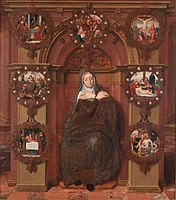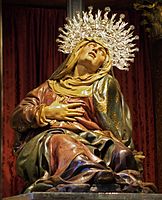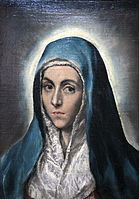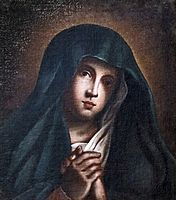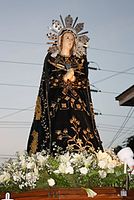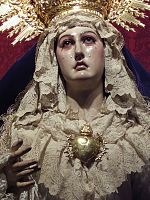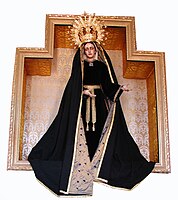Our Lady of Sorrows
Our Lady of Sorrows | |
|---|---|
Pakil, Laguna |
| Part of a series on the |
| Mariology of the Catholic Church |
|---|
 |
|
Catholicism portal |
Our Lady of Sorrows (
The Seven Sorrows of Mary are a popular religious theme and a
The feast of Our Lady of Sorrows is liturgically celebrated every 15 September, while a feast, the
Seven Sorrows of Mary
The Seven Sorrows (or Dolors) are events in the life of Mary that are a popular devotion and are frequently depicted in art.[1]
These Seven Sorrows should not be confused with the five
Traditionally, the Seven Sorrows are:
- The Prophecy of Simeon in Luke 2;
- The Flight into Egypt in Matthew 2;
- The Loss of the Child Jesus in the Temple of Jerusalem, also in Luke 2;
- Mary meeting Jesus on the Fourth station of the Crosswhich is not found in the Bible;
- The ;
- Jesus's Descent from the Cross in Matthew 27, Mark 15, Luke 23, and John 19;
- The Burial of Jesus by Joseph of Arimathea[2] also in Matthew 27, Mark 15, Luke 23, and John 19;
Devotions to the Seven Sorrows
Western Christianity

Earlier, in 1232, seven youths in Tuscany founded the Servite Order (also known as the "Servite Friars", or the "Order of the Servants of Mary"). Five years later, they took up the sorrows of Mary, standing under the Cross, as the principal devotion of their order.[3]
Over the centuries several devotions, and even orders, arose around meditation on Mary's Sorrows in particular. The Servites developed the three most common devotions to Our Lady's Sorrows, namely the
The Black Scapular is a symbol of the Confraternity of Our Lady of Sorrows, which is associated with the
Eastern Christianity

On February 2, the same day as the
It depicts Mary at the moment that
Liturgical feast
Our Lady of Compassion

The Feast of Our Lady of Sorrows grew in popularity in the 12th century, although under various titles. Some writings would place its roots in the eleventh century, especially among the Benedictine monks.[10]
The feast of the Our Lady of Sorrows was originated by a provincial synod of
According to Fr. William Saunders, "in 1482, the feast was officially placed in the Roman Missal under the title of Our Lady of Compassion, highlighting the great love our Blessed Mother displayed in suffering with her Son. The word compassion derives from the Latin roots cum and patior which means "to suffer with".[10]
After 1600 it became popular in France and was set for the Friday before Palm Sunday. By a Decree of 22 April 1727,
The Seven Sorrows of the Blessed Virgin Mary
In 1668, a separate feast of the Seven Sorrows of Mary, celebrated on the third Sunday in September, was granted to the

Since there were thus two feasts with the same title, on each of which the Stabat Mater sequence was recited, the Passion Week celebration was removed from the General Roman Calendar in 1969 as a duplicate of the September feast.[13] Each of the two celebrations had been called a feast of "The Seven Sorrows of the Blessed Virgin Mary" (Latin: Septem Dolorum Beatae Mariae Virginis). Recitation of the Stabat Mater was made optional.
On the second Sunday of September, the congregation of Maria SS. Addolorata in the Carroll Gardens neighborhood of Brooklyn, hold an annual procession with a statue of Our Lady of Sorrows. The tradition started in the 1940s with Italian immigrants from Mola di Bari celebrating the Feast of their hometown patroness, Our Lady of Sorrows.[14]
Iconography
Our Lady of Sorrows is often depicted with either one or seven swords piercing her heart, the first a reference to the prophecy of Simeon, the second to the Seven Sorrows. The type dates from the latter part of the 15th century.[15]
Patronage

Our Lady of Sorrows is the patron saint of:
- people named Dolores, Dolorita, Lola and Pia.
- The Congregation of Holy Cross[16]
- Order of the Servants of Mary[17]
- Sisters of Our Lady of Sorrows[18]
- Slovakia: 15 September is also a national public holiday[19]
- Poland: the icon Our Lady of Sorrows, Queen and Patroness of Poland (see also: Patron saints of Poland § Primary) was canonically crowned by Pope Paul VI on 15 August 1967.
- Mississippi, United States
- Lanzarote, Canary Islands
- Nuestra Señora de la Soledad de Porta Vaga, Queen and Patroness of the City and Province of Cavite, Philippines
- Ronda, Cebu
- Granada, Spain: September 15 is a public holiday in the city.[20]
- Mola di Bari[21] and the Molise region of Italy
Churches:
- Mater Dolorosa (Berlin-Lankwitz)[22]
- Our Lady of Sorrows Basilica, Chicago, United States[23]
- Our Lady of Sorrows Basilica, Šaštín-Stráže, Slovakia[19]
- Église Notre-Dame-des-Sept-Douleurs], Montreal, Canada
- Nuestra Señora de los Dolores, Montevideo
- St. Mary of Sorrows (Fairfax, Virginia)[25]
- Our Lady of Sorrows Church (Wahiawa, Hawaii)[26]
- Our Lady of Sorrows Church (Santa Barbara, California)[27]
- Our Lady of Sorrows Church in Ká-Hó, Coloane, Macau.
- Our Lady of Sorrows of Calolbon (Batong Paloway), Paloway, San Andres, Catanduanes, Philippines
- National Shrine of Our Lady of Sorrows, Dolores, Quezon, Philippines
- Pakil, Laguna, Philippines
- Church of Our Lady of Seven Sorrows (Czech: Kostel Panny Marie Sedmibolestné, lit. 'Church of Virgin Mary of Seven Pains'), Rabštejn nad Střelou, Czech Republic
- Our Lady of Compassion, Piedade, Goa, India
- Shrine of Our Lady of Sorrows, Starkenburg, Missouri[28]
- Church of Blessed Virgin Mary of Sorrows, Špansko, Zagreb[29]
- Church of Our Lady of Sorrows, Mrkopalj, Croatia[30]
- Basilica santuario di Maria Santissima Addolorata, Molise, Italy[31]
Gallery
Our Lady of Sorrows, depicted as "Mater Dolorosa" (Mother of Sorrows) has been the subject of some key works of Catholic Marian art. Mater Dolorosa is one of the three common artistic representations of a sorrowful Virgin Mary, the other two being Stabat Mater and the Pietà.[32]
In this
-
Mater Dolorosa with open hands, by Titian, 1554
-
Our Lady of Sorrows, by Pieter Pourbus, 1556
-
Madonna in Sorrow, by Juan de Juni, 1571
-
Mater dolorosa, by El Greco c. 1590
-
Dolorosa, Murillo, 1665
-
The Madonna in Sorrow by Giovanni Battista Salvi da Sassoferrato, 17th century
-
Mater Dolorosa The oldest image in the Philippines dating 1785 owned by the Macalalag Family in Iloilo City, Philippines.
-
Nuestra Señora de la Soledad de Porta Vaga, Philippines.
-
Our Lady of Sorrows, El Viso del Alcor, Seville, Spain.
-
Sorrowful Mother of Warfhuizen, Warfhuizen, Netherlands
-
Nuestra Señora de Dolores, Metropolitan Cathedral of Chihuahua, Mexico
-
Pakil, Laguna, Philippines
-
Dieric Bouts, Netherlandish, Mater Dolorosa, 1470–75
-
Our Lady of Sorrows in the Sacred Heart of Jesus parish
See also
- Mission San Francisco de Asís in San Francisco, California, known also as Mission Dolores
- Seven Joys of the Virgin
References
- ISBN 0-87973-910-X.
- ^ "Our Lady of Sorrows", Marian Library, University of Dayton
- ^ a b c d Holweck, Frederick. "Feasts of the Seven Sorrows of the Blessed Virgin Mary." The Catholic Encyclopedia Vol. 14. New York: Robert Appleton Company, 1912. 14 September 2021
 This article incorporates text from this source, which is in the public domain.
This article incorporates text from this source, which is in the public domain.
- ^ Order of Friar Servants of Mary: The Confraternity of Our Lady of Sorrows Archived 2013-01-13 at archive.today - retrieved on 22-Mar-2009
- ISBN 978-1-4086-6003-4, p. 301
- ^ Kosloski, Philip (2018-02-17). "A powerful novena in honor of the Sorrowful Mother". Aleteia. Archived from the original on 2018-06-13. Retrieved 2018-12-25.
- Sisters of Our Lady of Sorrows. 2016. Archivedfrom the original on 2018-12-25. Retrieved 2018-12-28.
- ^ ISBN 0-8028-4834-6pages 10-11
- ^ a b Orthodox life, Volumes 54-55, Holy Trinity Monastery (Jordanville, N.Y.) page 7
- ^ a b Saunders, William. "The Feast of Our Lady of Sorrows", Arlington Catholic Herald, 2000
- ^ "Memorial of Our Lady of Sorrows", Vatican News
- ^ "Calendarium Romanum", Libreria Editrice Vaticana, 1969, p. 103
- ^ Calendarium Romanum (Typis Polyglottis Vaticanis 1969). p.119
- ISBN 0-300-10310-7
- ^ Stracke, Richard. "Mater Dolorosa", Christian Iconography, Augusta University
- ^ Congregation of Holy Cross, US
- ^ "The Servites", The National Sanctuary of Our Sorrowful Mother
- ^ Sisters of Our Lady of Sorrows
- ^ a b O'Kane, Lydia. "Pope in Slovakia: Devotion to Our Lady of Sorrows", Vatican News, 14 September 2021
- ^ "Festividad de la patrona de Granada | Turismo de Granada". www.granadatur.com. Retrieved 2020-09-15.
- ^ "The Women in Black". 2007-09-10. Archived from the original on 2019-10-06. Retrieved 2022-05-25.
- ^ Mater Dolorosa, Berlin-Lankwitz
- ^ Our Lady of Sorrows Basilica, chicago
- ^ "Poveiros celebram Nossa Senhora das Dores – P. Varzim" (in Portuguese). MetroNews.
- ^ St. Mary of Sorrows, Fairfax, VA
- ^ https://www.olswahiawa.org/
- ^ Our Lady of Sorrows Roman Catholic Church, Santa Barbara
- ^ Shrine of Our Lady of Sorrows
- ^ Župa Blažene Djevice Marije Žalosne Špansko [Parish of Blessed Virgin Mary of Sorrows Špansko] Access date 17 September 2022.
- ^ Gospa Žalosna [Our Lady of Sorrows] Tourist Board of Kvarner. Access date 17 September 2022.
- ^ Basilica santuario di Maria Santissima Addolorata
- ISBN 1-4179-0870-Xpage 35
Further reading
- The Seven Sorrows of Mary, by Joel Giallanza, C.S.C. 2008, published by Ave Maria Press, ISBN 1-59471-176-3


